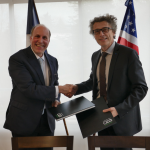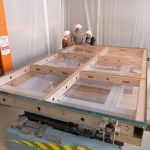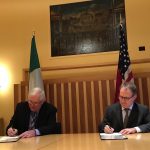From Agência FAPESP, May 1, 2019: Na última década foi iniciada, em diferentes países da América Latina, a operação de grandes infraestruturas de pesquisa, como o maior observatório de raios cósmicos do mundo, o Pierre Auger, na Argentina, e o Observatório Cherenkov de Água de Alta Altitude, no México. Nos próximos anos, devem ser concluídas as obras do Sirius – a nova fonte brasileira de luz síncrotron – e do Laboratório Argentino de Feixes de Nêutrons.
international partnership
From Agência FAPESP, April 30, 2019: O Instituto Sul-Americano para Pesquisa Fundamental (ICTP-SAIFR) sedia, nos dias 30 de abril e 1º de maio de 2019, o primeiro Fórum Estratégico Latino-Americano para Infraestrutura na Pesquisa (LASF4RI).
From Agência FAPESP, May 1, 2019: Colaborações científicas de longo prazo exigem grande infraestrutura de pesquisa. Um bom exemplo disso está na Europa, o Large Hadron Collider (LHC). Considerada a maior máquina do mundo, levou uma década para ser construída, envolvendo milhares de cientistas de 111 países.
From Space Daily, March 19, 2019: A major new physics facility at Fermilab is expected to have UK technology at its heart and lead to significant spin-off opportunities for UK companies.
The new PIP-II particle accelerator will power the Deep Underground Neutrino Experiment, which aims to address key questions about the origins and structure of the universe. The UK has committed a 65 million-pound investment to help build and operate DUNE, PIP-II and technology for the neutrino beam.
From UK Research & Innovation news, March 15, 2019: A major new physics facility at Fermilab is expected to have UK technology at its heart and lead to significant spin-off opportunities for UK companies.
The new PIP-II particle accelerator will power the Deep Underground Neutrino Experiment, which aims to address key questions about the origins and structure of the universe. The UK has committed £65 million investment to help build and operate DUNE, PIP-II and technology for the neutrino beam.
Scientist Jean-Paul Carneiro and collaborators in France are setting the stage for one of the world’s first autonomous particle accelerators. They will incorporate the world’s leading code for computing the dynamics of particle beams into a Fermilab prototype. Funding is provided through the FACCTS program, which fosters productive partnerships between Chicago-based and French researchers.
Agencies in the United States and France have signed statements expressing interest to work together on the development and production of technical components for PIP-II, a major particle accelerator project with substantial international contributions. In addition, the French agencies also plan to collaborate on DUNE, an international flagship science project that will unlock the mysteries of neutrinos.
The upcoming Short-Baseline Near Detector at Fermilab continues scientists’ search for evidence of a hypothetical particle, the sterile neutrino. Collaborators around the world are participating in the detector’s construction. Its first critical components recently arrived from partner institutions. When complete, SBND will be the third and final detector in Fermilab’s Short-Baseline Neutrino Program.
The agreement launches a multinational collaboration to build a powerful new accelerator at DOE’s Fermilab complex. Italy and its National Institute of Nuclear Physics will provide major contributions to the construction of the 176-meter-long superconducting particle accelerator that is the centerpiece of the PIP-II project.





